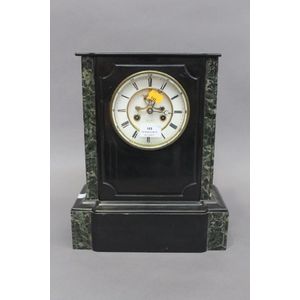Napoleon III Black Marble Mantle Clock
You must be a subscriber, and be logged in to view price and dealer details.
Subscribe Now to view actual auction price for this item
When you subscribe, you have the option of setting the currency in which to display prices to $Au, $US, $NZ or Stg.
- Pendulum - The pendulum was discovered around 1602 by Galileo Galilei, and was adopted for time keeping by the Dutch mathematician and natural philosopher, Christiaan Huygens, who excelled in astronomy, physics, and horology.
The pendulum comprises a metal rod usually of brass or steel with a metal disk, known as a bob, at the end. The movement of the pendulum is driven by weights or a spring, and as a pendulum swings in a regular arc, it was found accuracy could be controlled to within a few seconds a week.
Timekeeping can be adjusted by changing the height of the bob on the rod, making the pendulum either swing slower or faster.
The disadvantage of the pendulum was that changes in temperature also changed the length of the pendulum, interfering with the accuracy of the clock, and so in the 18th century two types of mercurial pendulums were invented which countered the movement in the steel rod.
The pendulum was the world's most accurate timekeeping technology until the invention of the quartz clock, regulated by a quartz crystal, in 1927. - Chapter Ring - A separate metal plate on the face of a clock, on which the numerals for the hours and sometimes parts of the hours, are displayed, usually wheel shaped and sitting on top of the dial plate. The chapter ring is often a feature of the clock and can be silvered or enamelled to stand as a contrast to its background. The hours are usually shown in Roman numerals, although in the late 19th and earlt 20th century, Arabic numerals became fashionable.
This item has been included into following indexes:
Visually similar items

A Jaeger LeCoultre 'Marina' Atmos clock, manufactured Switzerland, with aquarium theme Lucite panels, white enamel, dial and polished brass case. Height 23 cm

Antique French marble clock, has key and pendulum (in office C103.90B), 28 cm high, 25 cm wide, 14.5 cm deep

Antique French black and green marble mantle clock 'Levy Aron', has key & pendulum (in office), 36 cm high, 30 cm wide

A French mantel timepiece, C.1850. Small ebonised wooden case. Plain white enamel dial with hinged bezel. Compact size and nearly inaudible tick make it suitable for library or bedroom use, height 20 cm, width 21 cm
